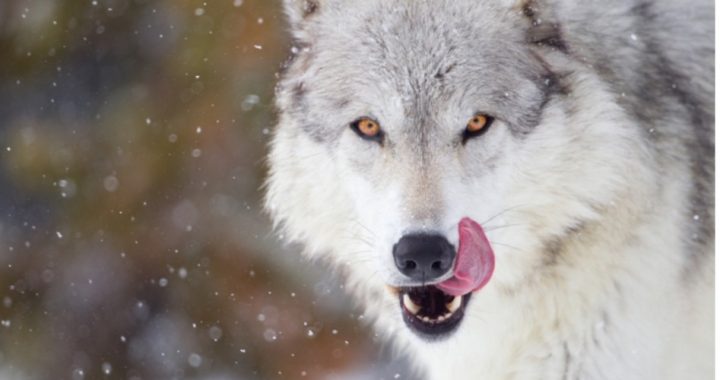
Will holdover Obama Swamp creatures at USFWS sabotage wolf delisting effort — again?
President Donald Trump’s Acting Interior Secretary David Bernhardt announced plans on March 6 to lift protections for gray wolves in the lower 48 states. Predictably, the announcement was immediately both praised and condemned. When the issue is wolves, it’s rural communities versus urbanites, Big Media, Big Green NGOs, and entrenched bureaucrats of the DC Swamp. And up until now, the lavishly funded urbanite wolf lobby has been winning most of the rounds. The Trump administration’s announcement could signal a sea-change toward the other direction.
“This is welcome news to farmers and ranchers,” said the American Farm Bureau Federation in a press release. “The agency’s intent to delist the gray wolf is a triumph of common sense we all should herald as a conservation success story.”
“There are more than 5,000 gray wolves in the United States and more than 10 times as many over the Canadian border,” the Farm Bureau press statement continues. “The U.S. population of gray wolves far surpasses the recovery targets called for by the Endangered Species Act. Populations have reached critically high numbers in many states — so high, in fact, that wolves are not just preying on livestock, but pushing elk and deer onto U.S. farms and ranches, which leads to even more destruction. The administration’s decision to de-list the gray wolf is the culmination of a decades’ long battle that has pitted science-based decision making against litigious, environmental activism.”
Other organizations representing rural communities, farmers, ranchers, hunters, campers, outdoorsmen, and recreation interests echoed the Farm Bureau’s support for the proposed wolf delisting. “Unfortunately, as ranchers know all too well, the current Endangered Species Act rarely functions as Congress originally intended,” said Jennifer Houston, president of the National Cattlemen’s Beef Association, and Bob Skinner, president of the Public Lands Council, in a joint statement. “Radical environmental activists use an endless cycle of lawsuits and procedural tricks to thwart effective conservation,” they remarked. “That is why it has taken so long to delist the gray wolf, even though science has long shown the species had reached stable population levels.” They commended “Acting Secretary Bernhardt and his team for making this science-based decision.”
On the other hand, militant environmentalist groups denounced the proposal and have vowed to fight it in court. “This proposal by Acting Secretary of the Interior David Bernhardt to remove wolves from the list of endangered species is another egregious example of the Trump administration’s relentless assault on wildlife protections,” charged Jamie Rappaport Clark, president and CEO of Defenders of Wildlife. “The return of the wolf to the northern Rockies and Great Lakes is one of America’s greatest conservation successes, but wolves are still absent from much of their historic range where there is suitable habitat,” she said. “The work of recovering this iconic species is not done and we will vigorously oppose this action.”
Likewise, the Center for Biological Diversity denounced the delisting decision. “This disgusting proposal would be a death sentence for gray wolves across the country,” said Collette Adkins, a senior attorney at the Center. “The Trump administration is dead set on appeasing special interests that want to kill wolves. We’re working hard to stop them.”
Representatives Earl Blumenauer (D-Ore.) and Vern Buchanan (R-Fla.), co-chairs of the Congressional Animal Protection Caucus, released the following statement on the proposal:
The plan to remove gray wolves from the Endangered Species list is deeply concerning. These iconic creatures are integral to ecosystems across the country and many regions are beginning a fragile recovery. This proposal would threaten that possibility. We will continue to fight to preserve endangered species that are so critical to our country’s heritage.
Facts Versus Fears, Myths, Lies
As we have reported previously in The New American (see for instance here, here, and here), federal bureaucrats at the U.S. Fish and Wildlife Service (USFWS) and their allies in the Big Green environment organizations have been engaged in a mammoth, decades-long deception regarding the wolf “recovery” program, introduced in 1975. In 1995, the USFWS began introducing Canadian gray wolves into Montana, Idaho, and Wyoming. The Canadian grays are a subspecies that is not native to, and are much larger than, the wolves that were once common to the United States. As such, they are an invasive species, not a native recovering species. We reported in 2009:
When the plan to introduce the Canadian wolves into the United States was adopted, federal officials said the goal was 100 wolves per state, or 300 wolves total [for the Rocky Mountain states of Idaho, Montana, and Wyoming]. Using that well-proven weapon of bureaucrats and environmentalist lawyers, the Endangered Species Act (ESA), the U.S. Fish and Wildlife biologists argued that there was no reason to get worked up over a few wolves. As soon as ten wolf packs with one breeding pair each were confirmed to have litters for three consecutive years in any of the three recovery areas, the wolves in that area would be downgraded on the ESA list from “endangered” to “threatened” status. And when at least ten packs with breeding pairs had successfully brought forth litters in every one of the three states for three years in a row, the wolves would be “delisted,” meaning they would be removed completely from the Endangered Species List.
As far back as 2002, the USFWS officially acknowledged that it had achieved the stated goal of 100 wolves per state and 300 total for the three states. Critics argued that the wolf populations had eclipsed those numbers years earlier. However, having achieved their earlier stated goals, the wolf advocates simply moved the goal posts, not only upping the numbers again and again, but also pushing the expansion of wolf territory to new states. A decade ago, in 2009, the Idaho Department of Fish & Game reported that there were already over 1,000 wolves confirmed in the state. “We reached biological recovery levels in 2002 of one hundred wolves in each state and ten breeding pairs,” noted the Department’s James W. Unsworth. “We’re eight times over those recovery levels, at a very minimum.”
Wolf predation has had a devastating impact on elk, deer, moose, caribou, bison, and bighorn sheep populations in the Rocky Mountain states. Experts in wildlife biology have been warning for many years that the federal government’s wolf program is destroying our wild ungulate herds, in addition to the threat it poses to farming and ranching. Among the wolf experts who have provided detailed research and testimony concerning the danger are: Dr. Valerius Geist, Professor Emeritus of Environmental Science at the University of Calgary in Alberta, Canada; Wild life ecologist Dr. Charles E. Kay, Adjunct Associate Professor in Political Science and a senior research scientist with the Institute of Political Economy at Utah State University; and Jim Beers ,retired U.S. Fish & Wildlife Service wildlife biologist and refuge manager. Even some of the most avid wolf advocates — such as Ed Bangs, former U.S. Fish and Wildlife Service wolf recovery coordinator for the Northern Rockies, and Professor David L. Mech, founder of the Minnesota-based International Wolf Center — agree that unless wolves are hunted they will soon outstrip their habitats.
Will USFWS Swamp Creatures Sabotage Trump Wolf Delisting?
From past experience, we can be sure of several things: 1) Big Green radicals from Defenders of Wildlife, Center for Biological Diversity, etc., will launch suits against the USFWS to stop the delisting; 2) A federal judge can probably be found (or is already lined up) to decide in their favor; 3) The establishment Fake News media will create a clamor on behalf of the darling feral canids; 4) Anti-Trump swamp creatures at the USFWS will sabotage the delisting effort, while putting up a pretense of attempting to defend and implement it.
It is the fourth point that President Trump and Acting Interior Secretary David Bernhardt will have to be most concerned with, if they intend to see the wolf delisting carried out. Thousands of employees from the Bush and Obama eras still inhabit the “D.C. Swamp,” including the USFWS. Many of these swamp dwellers refer to themselves as “the Resistance” inside the Trump administration. They no doubt consider themselves loyal allies of Jamie Rappaport Clark, who, as mentioned above, is the head of Defenders of Wildlife. Clark was also their former boss, having been appointed head of the USFWS by President Bill Clinton. In that post, she played an important role in implementing the calamitous wolf program. Clark is but one of many radical greens on the revolving-door gravy train between federal agencies such as USFWS, EPA, Forest Service, Bureau of Land Management and Big Green NGOs. As CEO of Defenders of Wildlife (2017 revenue of $34 million) Clark is handsomely rewarded ($410,912 annual salary) to perpetually bring lawsuits, while also calumniating hardworking, taxpaying farmers, ranchers, miners, loggers and others who produce the basic commodities Americans want and need.
The Big Green radicals and the government bureaucrats with whom they publicly clash actually have a symbiotic relationship that often includes some carefully contrived political theater. The fake wrestling match between these two opponents was described thusly by Professor Charles E. Kay:
If you follow ESA issues, you know that the Greens win most of the lawsuits they file against the USFWS. That could be due to one of two things, incompetent federal biologists or the fact that the USFWS sets the lawsuits up to lose! Here is how it works. The USFWS makes a ruling, like wolf delisting, that appears to favor state or local interests, thereby alleviating political pressure on the agency and calls for Congress to cut the USFWS’s budget or revise the Endangered Species Act. The ruling “outrages” the Greens who sue and win, which allows the USFWS to claim that they tried to do the right thing; i.e., what they promised the public in the Final Environmental Impact Statement (FEIS), but now they can’t because they have to comply with the court order.
The political theater described by Professor Kay played out under Presidents George W. Bush and Barack Obama, both of whom proclaimed (unconvincingly) in favor of delisting the grey wolf. President Trump may actually intend to do more than mollify his rural state constituents with empty gestures. However, in order to be successful, he will have to carry out some swamp draining at Interior and USFWS, or we are likely to see another replay of the failed delisting efforts during the Bush and Obama administrations.
Photo: KenCanning/E+/Getty Images
Related articles:
Ranchers Face Wolves at the Gate
Wolf Danger: Idaho Lawmakers Pass Emergency Measure
NatGeo’s “Wolf Wars” Flacks for Radical Greens
Wolves Will Thrive Despite Recent Hunts
Court Favors Wolves, Endangers Elk, Moose and Humans



